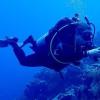- Linear penetration distance: 2,800 feet.
- Environment: Fresh water to approximately 60 feet, halocline to approximately 70 feet, salt water below 70 feet.
- Maxium depth: 148 feet. Average depth: 110-120 feet.
- Total run time: 3 hours, 10 minutes (including one hour plus decompression).
- Water temperature: 75 degrees.
- Equipment used: Two Optima CCRs and one Megalodon CCR plus open circuit bail out and decompression gas including 21/35 Trimix, Air, EANx70 and 100 percent oxygen staged and carried by a team of three divers.
- Total number of people to reach this spot throughout global history: 9 (including our team on this trip)!
By Marc Laukien
July 2007
Brian didn’t exaggerate: the room is gigantic. Despite a breathtaking 300 feet of visibility, I cannot fathom where it ends. I feel like floating in space.
Welcome to “Wrigley Field,” a huge cavern in Dan’s Cave, recently discovered by cave explorer Brian Kakuk. This is the last dive of the three best days of diving in my life: a 2,800 feet long and up to 145 feet deep dive that lasts for over three hours, including an hour of decompression. Fewer people have seen this room than men have walked the moon.
But I’m getting ahead of myself. This is a trip report, so let’s step back and start from the beginning.
I first read about Brian Kakuk’s “Bahamas Underground” in Advanced Diver Magazine just over a year ago. Bahamas Underground is located in Marsh Harbour on Great Abaco Island. Marsh Harbour is a small town of only 5,000 people, yet it is the third largest town in the Bahamas. I have been in Abaco several times for open water diving and family vacation. What I didn’t know was that Abaco has the finest cave diving on the planet. I had heard about the many blue holes on Andros and the Lucaya Caverns on Grand Bahama, but I never considered Abaco a cave diving destination.
Marsh Harbour is a nine-hour boat ride away from where I live in Florida. There are also several flights leaving from various Florida airports to Marsh Harbour every day, but I prefer to take my boat. My 26-foot Glacier Bay power catamaran, customized for diving, is a small boat for such a long trip, but the ocean is very calm in July.
I initially wanted to do this trip last year, but I had to cancel twice. The first time my boat was not ready, and the second time the weather turned bad and we couldn’t safely cross the Gulf Stream.
A lot had changed since last year. First, I had transitioned from open circuit diving to rebreather diving. Second, my cave diving buddy from last year had to move back to Europe, and therefore couldn’t join me on this trip. Thankfully, my change to rebreather diving brought me many new dive buddies, among them Howard Packer (aka “ScubaDadMiami” on Rebreatherworld), who was excited at the opportunity to join me on this trip.
Going by boat had the advantage that we could take a lot of gear with us: two Optima rebreathers, two 40cf deco and four 80cf bailout bottles, scrubber, an extra set of rebreather bottles, dive lights, video camera, dive suits, essential tools, and so on—my small boat was packed! I had already taken care of preparing the boat a few days before the trip (to check the engines, the boat electronics, and so on), so on the day of our departure, at 4am in the morning, all that was left to do was to store all our gear, and off we went… or so we thought.
Well, we had made it about halfway across the Gulf Stream, as I suddenly heard my port engine roaring. The RPMs went through the roof, so I quickly shut down the engine. After some investigation (in the middle of the ocean), we found that, for no apparent reason whatsoever, we had spun the hub of my left engine’s prop. We had only one option left, to slowly go back to Florida—on a single engine. It took us one and a half hours to get halfway across the Gulf Stream, but nearly five hours to get home again. We were both extremely frustrated. Was this to be the end of our trip?
But we didn’t give up so quickly. It was Sunday, with all repair shops closed, but we were lucky: my Glacier Bay dealer was in his office, and he had a spare prop in stock. So off we went up Route 95, picked up the prop, drove back to my place again, and pulled my boat up a muddy beach off the Intracoastal Waterway, where we exchanged the faulty prop.
Since it was late, and we didn’t want to arrive in Marsh Harbour in the middle of the night, we decided to leave the next morning. This time, the ride was flawless, and we arrived tired but safely in Marsh Harbour. Having waited for a grumpy immigration officer for a while, and then carried all our gear into our hotel room, we were ready for an early dinner and a good night’s sleep.
Brian picked us up the next morning. We first went to his shop, where he collected his Megladon rebreather. Brian’s dive shop is well equipped with everything the technical diver needs. He has a lot of gear available for rent, backmount rigs, sidemount rigs, and even a Megladon rebreather. Of course, he also has a well-maintained fill station, O2 tanks with booster, and everything else the technical diver needs.
Brian is a very experienced diver and cave explorer. Besides guiding dives for “tourists” like us, he also does a lot of research work for the Bahamian government, and has worked for film productions such as “The Cave” and “Pirates of the Caribbean.” He also taught Nitrox diving to Jessica Alba while being dive safety officer for the production of “Into the Blue”. On top of all this experience, Brian is also a very nice person, and a pleasure to dive with.
After we left Brian’s shop, we went straight for our first dive in Dan’s Cave. Getting into the basin with dive gear is very easy, even without the permanent steps that you find at Florida caves. It didn’t take us long to gear up and to enter the cave.
I have seen pictures of decorated caves before, but nothing prepared me for what I encountered after passing the halocline. I was completely in awe of the beauty of this cave. Never in my life had I seen anything like this. And it just kept getting better and better while Brian guided us deeper into the cave. The visibility was breathtaking (I didn’t even know that water was physically able to produce 300 feet of visibility), and there was no flow whatsoever. We saw thousands of stalagmites and stalactites, some as thin as a finger, others as thick as a giant sequoia tree. We saw large crystal formations in vibrant colors, and even the rock seemed to come in different variations, ranging from bright white and flat to red and spiky. The whole cave looked surreal, like from a fantasy movie. I truly had arrived in wonderland!
Our second dive of the day lead us to a different section of Dan’s Cave that was very different. It reminded me of an oversized version of Ginnie’s or Jackson Blue, with occasional stalagmites and stalagmites and crystal formations. Also, there were fossils everywhere we looked. We completed a circuit with a maximum depth of 140 feet in a little bit over an hour. Dan’s Cave truly has many different faces!
For the next day, I wanted to do a sea cave—my first. We had to start later because ocean caves are strongly influenced by tides. The water was much warmer than in the inland caves, so I only took a 3mm wetsuit. We waded for about 100 feet, and then swam another 100 feet, which brought us right on top of Broken Reel Cave. Broken Reel was a much tighter cave, and very silty, too. In some of the restrictions, visibility approached zero. However, it usually takes only a few minutes for visibility to clear up again because of the tidal flow and because the silt is quite coarse. We started our dive a little bit too late, so we had to fight the tidal flow twice, on our way in, and on our way out again.
Ocean caves are very different from inland caves. Marine life is everywhere: lobsters (hundreds), crabs, fish, and all kinds of other critters. Reef gloves are a must because the rock is sharp and covered with sponges. Broken Reel Cave is not nearly as beautiful as Dan’s Cave, but it is very different from all the inland caves I’ve seen, which made the dive a wonderful experience.
Our second dive of the day was dedicated to taking video in Dan’s Cave. We took the same passages as during our first dive. At the time of this writing, I am editing the video, and will soon make it available for download. Stay tuned!
This brings me to our last day of diving, again in Dan’s Cave. Brian tells us that he just recently has discovered a huge room that he named “Wrigley Field”. Wrigley Field is 2,800 feet from the cave entrance, at depths up to 145 feet. This makes it Howard’s and my longest and most challenging cave dive ever. We plan the dive thoroughly: Brian draws the approximate dive profile from his memory, and I punch the numbers into V-Planner to calculate our bailout plan. We take two 80cf bailout bottles each, one of which we drop about halfway to our destination. We also stage two 100% O2 and one 70% O2 bottle near the entrance.
While long, the swim to Wrigley Field is everything but boring. The cave just keeps getting better and better the farther we go. The columns grow to the height of multi-story buildings. A few times, I think that we have reached Wrigley Field already because the rooms are so large, but Brian keeps going. There are more, larger rooms to come.
Finally we are there. My light cannot penetrate to the walls. Only after swimming around for ten minutes do I start to grasp how large this room really is. This is truly the crowning dive of the most wonderful dive trip I ever made. During the hour of decompression at the end of the dive, the only thought in my mind is when I can come back again for more.
Our three days of diving are over way too fast, and after a good dinner with Brian and some of his fellow explorers, it’s time to say goodbye. We are heading home the next day but, in our minds, we are still at Wrigley Field.


















